Last Updated on July 8, 2021 by Staff
Countless videos and blogs on “how to use chopsticks” recommend that users learn to hold the top chopstick like a pen. That is a sound advice. We teach the same in Learn to Use Chopsticks as well.
But what does “hold it like a pen” mean, exactly? Does everyone actually know the right way to hold a pen? What if there are as many alternative pen grips, as there are alternative chopstick grips? And, is there a “standard pen grip”, like there is a standard chopstick grip?

Table of Contents
Are pen grips and chopstick grips correlated?
If you learned a non-standard pen grip as a child, will that influence the type of chopstick grip you adopt later?
We don’t have answers to this question, nor to some of the questions stated earlier. You won’t find answers elsewhere either. Researchers have not explored these questions. They haven’t even come to reckon with the reality of the richness of chopstick grip types, yet.

Here we attempt to collect and analyze pictures of folks using pens and chopsticks. It is just a starting point. We collect pictures from folks where the same person uses a pen and then chopsticks. By acquiring and analyzing these pictures, we can start to look for patterns including correlations. We will thus establish some basic facts for further research.
Wisdom from chopstick wrappers
Instructions on how-to-use-chopsticks abound. You can find them on most chopstick wrappers for disposable chopsticks. As we have recounted in Vulcan Grip and Righthand Rule, these instructions are accompanied by horribly-inaccurate drawings. But in many cases, succinct written instructions include the phrase “hold it as you hold a pencil”. We applaud this recommendation.
We like it so much that we have incorporated it into our article on Learn to Use Chopsticks. Below is one of the video clips showing the first step of the learning process. Step 1 is to hold the top chopstick like a pen. The end result is a three-finger maneuver that we call the “tripod hold”.
Who said this is the right pen grip?
Unlike the sad, unresearched field of chopstick grips, the best way to hold a pen has been well-documented online, as well as in books. This website, for instance, documents both the tripod grip and the quadropod grip for holding a pen. The same tripod grip is illustrated in the 1923 treatise on penmanship by Caswell, shown below.
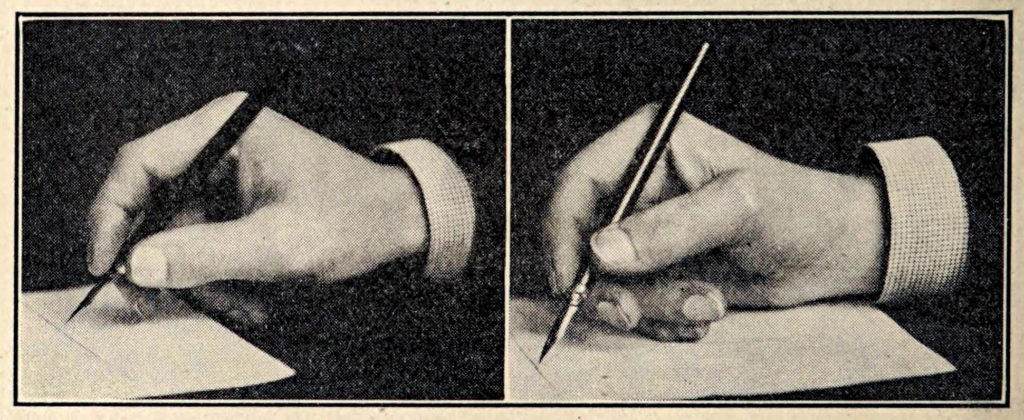
The book showed two closely-related variants of the tripod grip. For reasons that will be explained later, we will call the above left posture the Caswellian Grip, and the above right posture the Spencerian Grip.
It turns out that the same tripod grip is exactly how the top chopstick is manipulated by the same three fingers: the thumb, the index finger and the middle finger.

We call the alternating motion of three fingers moving the top chopstick between the closed posture and the open posture, the planetary gear train twirling of chopsticks. Following video illustrates this alternating motion.
Alternative ways to grip a pen
There are as many ways to grip a pen as there are for holding chopsticks. Two pictures below show the same person using two different pen grips. On the left is an alternative grip where the index finger is over-flattened, to the point where the finger hurts. This grip was acquired in childhood. On the right is a tripod grip with a curved index finger that this person adopted in adulthood.
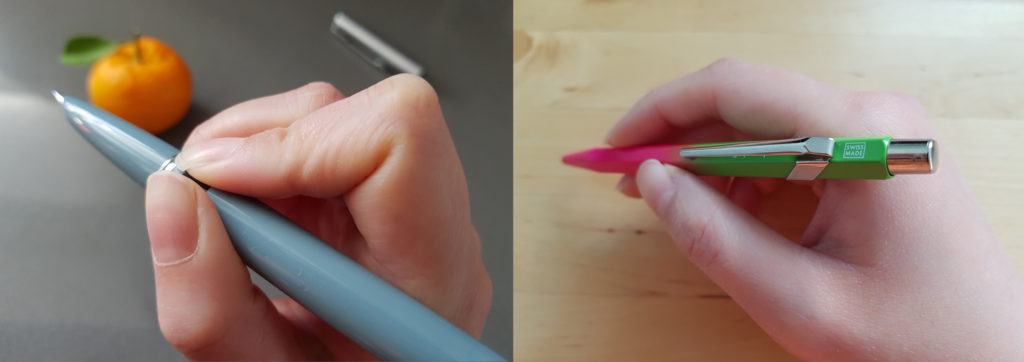
For reasons that will be explained later, we will call the above left posture the Modern Grip. The above right posture is another example of the Spencerian Grip.
Two more common pen grips are shown below. They are very similar. Both grips forgo the use of the tip segment of the thumb. Only the base of the thumb is used to grip the pen. The person on the left wields chopsticks with the Idling Thumb grip. The person on the right wields chopsticks with the Scissorhand grip. These resemble the pen grip that some people call the lateral tripod grip. See these research drawings and pictures. We will call it the Lateral Grip here.
It is worth pointing out that Idling Thumb is named precisely after the tip of the thumb that eschews any responsibilities in maneuvering the top chopstick. This characteristic of chopstick wielding appears to be correlated to how the same person wields a pen (above left).
Similarly, Scissorhand inherits the same idling thumb, because it is derived indirectly from Idling Thumb. This relationship is visually described in the family tree of alternative grips. Again, this disuse of the thumb appears to translate to the pen grip as well (above right).
All four variants mentioned so far are tripod grips. But they do not all operate using the same finger dynamics. Only the Spencerian and the Caswellian variants enable a writer to freely twirl the pen using the planetary gear train principle. The Modern and the Lateral variants lock the pen in a firm grip, allowing it very little freedom of movement.
Standard Grip users
In general, people who twirl chopsticks using Standard Grip also hold pens using the tripod grip. More specifically they tend to adopt either the Spencerian variant, or the Caswellian variant. This is an empirical observation based on anecdotal evidences, and is subject to revisions as we collect more data. Following pictures illustrate various views of the same Standard Grip.

Following are views of the same user holding a pen using the Caswellian Grip. Take note of overall similarities between the chopstick grip (above) and the pen grip (below).

That being said, there are some minor differences between the chopstick grip and the pen grip. For instance, in holding a pen, the thumb does not need to extended completely flat, in a Caswellian thumb pose, as described in details in Caswellian Thumb and Chopsticks, and in Count-to-4. This is because there isn’t a second pen for the thumb to secure, as is the case with chopsticks.
Pictures below illustrate how a different Standard Grip user holds a chopstick like a pen (left), versus how the same user wield chopsticks (center and right). The thumb in the pen grip (left) is positioned opposite the index finger. This is slightly different from the standard chopstick grip (center and right), where the thumb is positioned further aft.

Here are similar views of yet another Standard Grip user. The picture on the left shows the Spencerian Grip. Note the slight change in the position of the thumb, with respect to the positions of the index finger and the middle finger. The thumb is located further aft, compared to these other fingers. The pen grip of this user is visually closer to the standard chopstick grip, except that the thumb is bent, instead of being extended flat, in a Caswellian thumb pose.

Two traditional pen grips
Two variants of traditional pen grips exist. They were popular for writing cursives using fountain pens. They are both examples of tripod grips. The Caswell treatise shows both variants. Unlike some variants such as the Modern Grip, these traditional grips demand that writers rest the rear of the pen on the base of the index finger. This is exactly how the Standard Grip works as well, when it comes to wielding chopsticks.
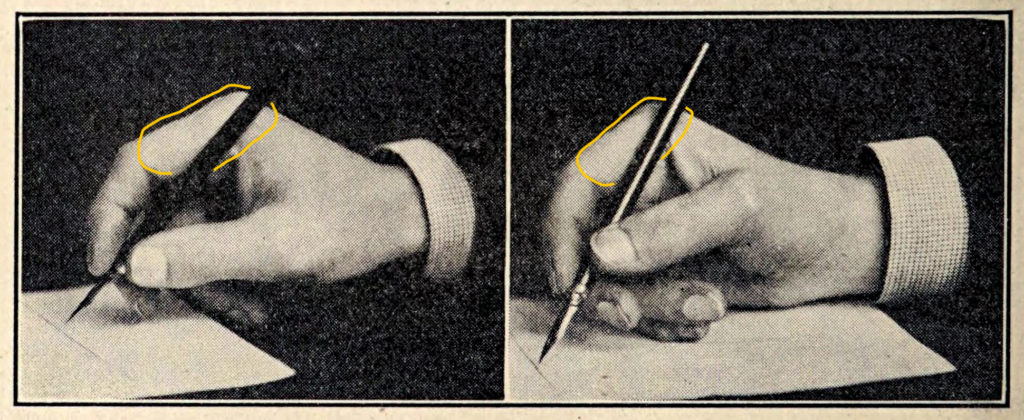
These two variants are slightly different. The variant on the left has writers turn their wrist, with the palm facing down. This allows the index finger to exert downward forces on the pen. The variant on the right has the hand turned such that it can sit on the flesh of the pinky. These distinctions are not important to chopstick wielding. For the sake of this article, we ignore these differences.
Instead, we want to use these two variants to show two ways the thumb may be positioned. We have marked out the contour of the thumb in these two pictures (below), to highlight their differences.
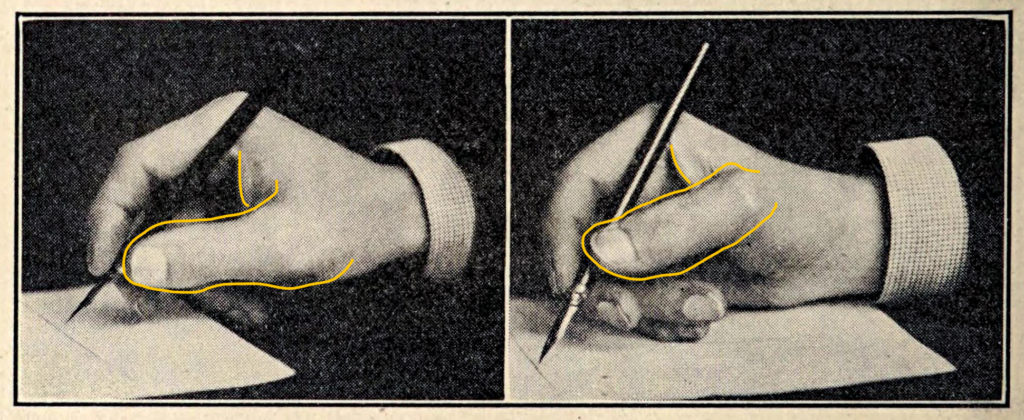
For the sake of our discussion, we term the first variant the Caswellian Grip, shown below. The purlicue is stretched taut, by the base of the index finger and the base of the thumb. This allows the tip of the thumb to reach forward and meet with the tip of the index finger. We name it after the author of the book.
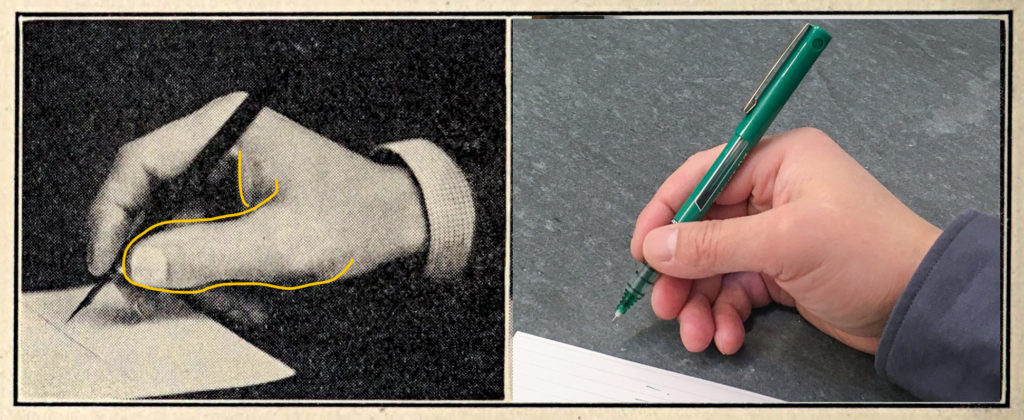
We term the second variant the Spencerian Grip, shown below right. This is where the base of the thumb raises up, bringing itself closer to the base of the index finger. The tip of the thumb is raised in the process, distancing itself from the tip of the index finger. A different way of raising the tip of the thumb is shown below left. Instead of raising the base of the thumb, the first joint of the thumb is bent instead.

It doesn’t matter whether one uses Caswellian Grip or Spencerian Grip. The both work well. People usually adopt whichever grip better accommodate their anatomy and habit.
For the curious who want to dive further into the rabbit hole, see this, this, this, this, this, and this on pen grips.
The Modern Grip
It seems that schools now teach a different pen grip. We call this the Modern Grip. It is still a tripod grip, in that the thumb, the index finger and the middle finger securely hold the pen. It is generally known as the Dynamic Tripod penhold. But this grip has the pen rest on the purlicue, the web between the index finger and the thumb. This seemingly small detail has grave implications for finger dynamics. Firstly, the planetary gear-like rolling of the pen cannot be done. Secondly, this grip invites writers to over-flatten the index finger, as shown below.
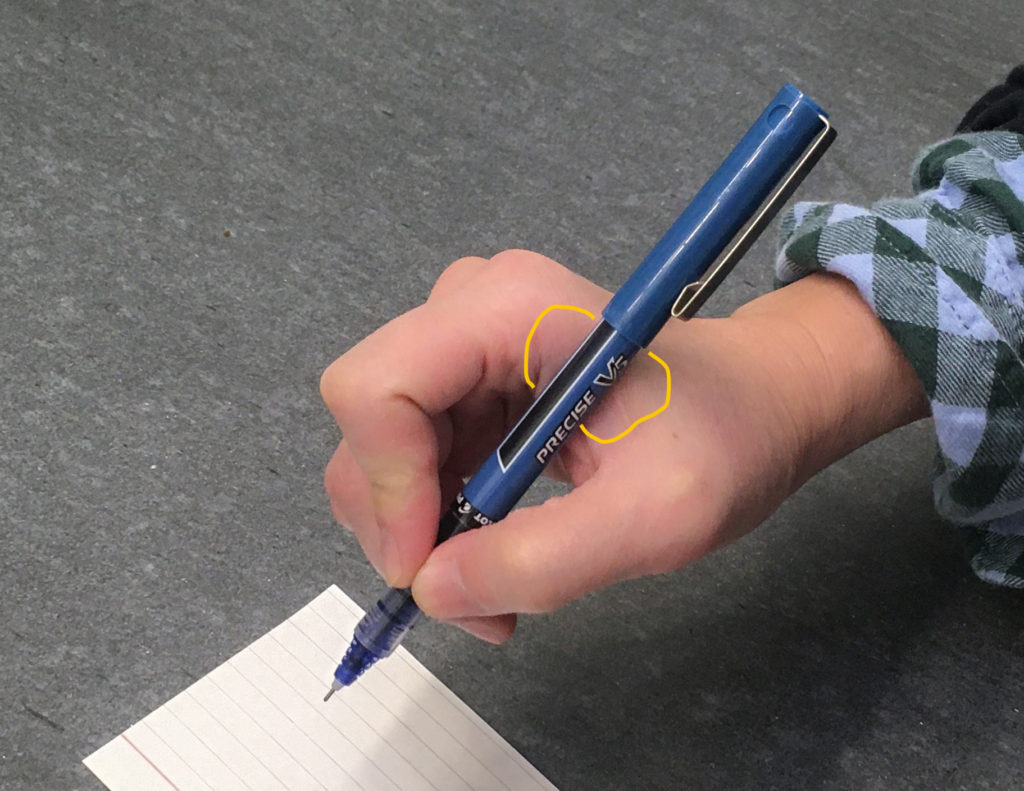
It is undesirable for the index finger to over-extend, shown again below. This reduces the flexibility of finger movements. It thus negatively affects writing dexterity. The same is true of chopstick twirling. Never over-extend the index finger.
Four common pen grips
Here is a summary of the four common pen grips we have discussed so far. They are shown below. From left to right, we have Spencerian Grip, Caswellian Grip, Modern Grip, and Lateral Grip.

It seems reasonable to consider Modern Grip as a cross between Caswellian Grip and Lateral Grip. After all, Modern Grip shares the thumb posture of Caswellian Grip, and the pen-resting-on-purlicue posture of Lateral Grip.
Idling Thumb and its child grips
The rest of this article will be dedicated to examination of correlation or lack thereof, between pen grips and chopstick grips. We will focus on chopstick grips that derive from the Idling Thumb grip, for this discussion.
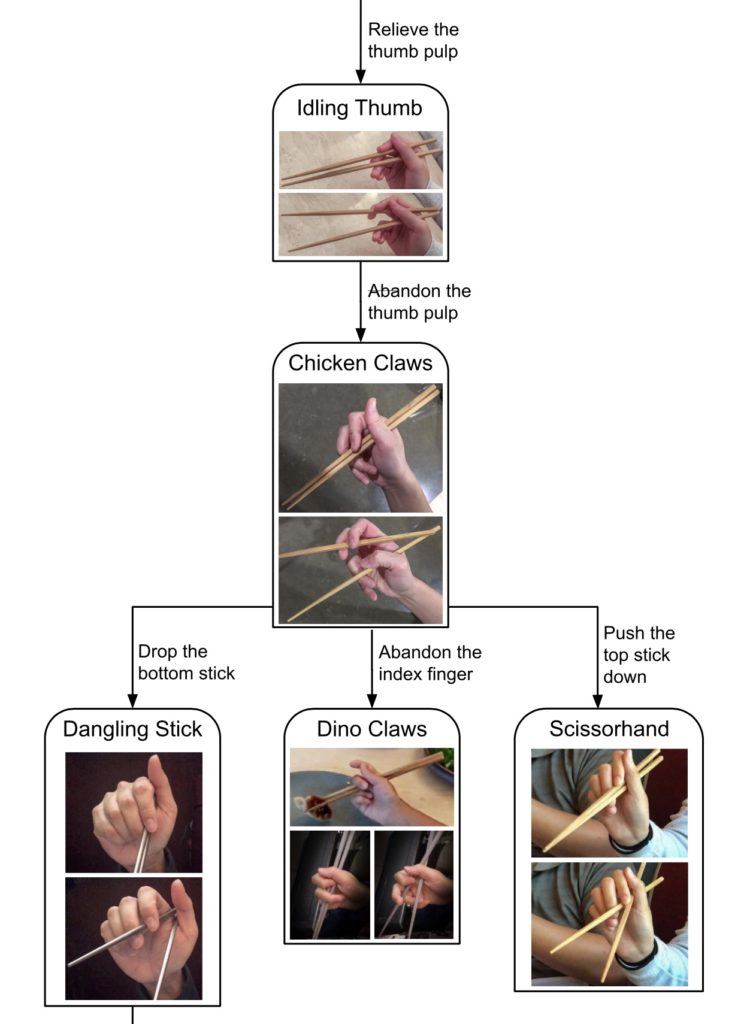
Idling Thumb users
The picture below to the left shows one Idling Thumb user holding a pen using the Lateral Grip. Notice similarities between pen grip and chopstick grip. In both cases, the thumb loiters. The tip of the thumb is not used to manipulate the pen nor the top chopstick. Also note how the index finger is over-extended. This reduces overall dexterity.

As we repeatedly underscore in our articles on various alternative grips, users do not always have just one chopstick grip in their repertoire. A user may switch to different variants of a grip, or to a related grip, as situations call for.
Following pictures show that an Idling Thumb user adopted two different pen grips only minutes apart, when prompted to demonstrate pen-holding grips using a chopstick. The user showed the Modern Grip at first (left). Later the user subconsciously switched back to their usual Lateral Grip (center).

Chicken Claws users
Following picture (left) captures how a Chicken Claws chopstick user holds a pen using the Modern Grip. We expected that the user would use the Lateral Grip for the pen, as Chicken Claws derives from Idling Thumb. But in reality, this user wields the Modern Grip instead.

We suspect that the discrepancy between pen grip and chopstick grip is influenced by childhood exposure to the Modern Grip at school.
Modern Grip vs Caswellian Grip
Now seems like a good time to compare Modern Grip to Caswellian Grip. Following are views of the same user holding a pen using the Modern Grip. In these views, the index finger is shown to be over-extended past the flat posture. The index finger actually curves in as the user applies pressure to hold the pen. As discussed earlier, Modern Grip rests the pen on the purlicue.

Compare above pictures to following views of a different user holding a pen using the Caswellian Grip. In all views, the index finger is shown to retain a convex shape. This allows the user to exercise fine muscle controls, resulting in enhanced dexterity. In fact, both tip and center segments of the index finger hug the pen. It is impossible for the writer to over-extend the index finger using this grip. By hugging the pen, the index finger turns the pen into an extension of itself. This is why the rear end of the pen naturally rests on the base of the index finger.

Dangling Stick users
Pictures below illustrate how a Dangling Stick user holds a chopstick like a pen (left), versus how the same user wields chopsticks (center and right). Just like the case with Chicken Claws discussed earlier, we expected the Dangling Stick user to have adopted the Lateral Grip. But instead we find that this user has also adopted the Modern Grip. In this case, no over-extension is observed.

Fork grips vs. Chopstick grips
Here we take a detour to explore how people grip forks. Shown below to the left and in the center are views of a person holding a fork. This is very similar to the Quadropod Grip mentioned earlier, for pen grips. This same person wields the Dangling Stick when it comes to using chopsticks.
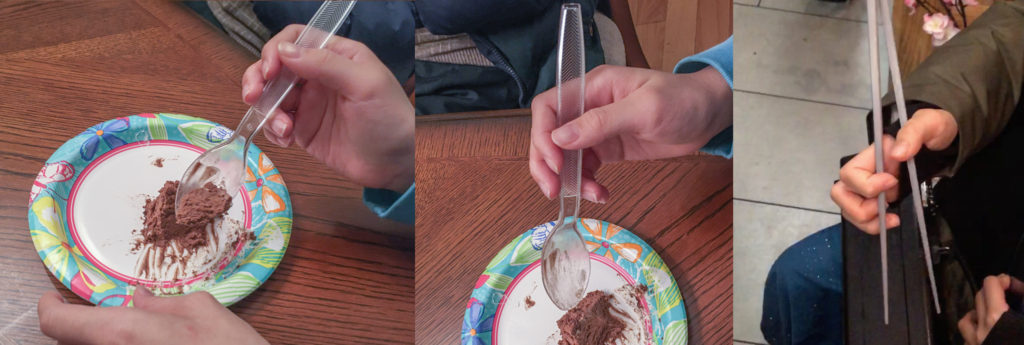
On the other hand, some people do use the same grip for fork and for chopsticks. Shown below are views of a person applying to forks (left) the same Dino Claws grip they use for chopsticks (right). This fork/pen grip looks like a cross between Quadropod Grip and Lateral Grip. We’ll call it the Lateral Quadropod Grip.
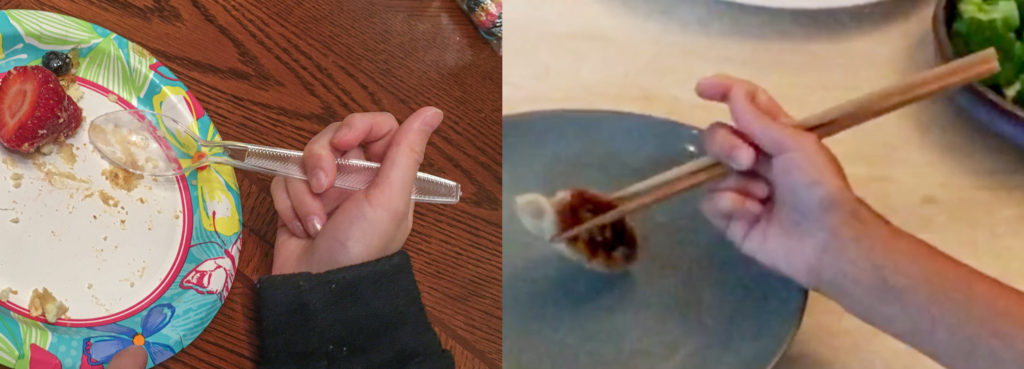
Shown below are another perspective showing the same fork grip and chopstick grip. The index finger is clearly not used. Perhaps calling it “quad” anything is not quite correct, after all. There are only three contact points in use: the thumb base, the middle finger, and the ring finger.
Scissorhand Grip users
Here is another example where correlation holds between pen grips and chopstick grips. Shown below to the left is a picture of a person holding a pen using a variant of the Lateral Grip. The thumb has been moved towards the tip of the pen, compared to the prototypical Lateral Grip posture. The same person wields chopsticks with the Scissorhand Grip. Both pen grip and chopstick grip share the same disuse of the thumb tip, as well as the same flattened index finger, for applying force.

When prompted to hold a chopstick as if holding a pen, this person takes up the same pen grip (below left). The three pictures to the right show the same person forcing open the top chopstick, using a flattened index finger.

This concludes our discussion on grips that derive from Idling Thumb. Now we tie a few lose ends before we end this article.
Count-to-4 users
Here is a rarer pen grip. It is yet another example confirming the correlation between pen grips and chopstick grips. The same person wields a pen (below left) using exactly the same finger posture and dynamics as they wield chopsticks (below center and right). We call this chopstick grip the Count-to-4 grip. It has a Vulcan variant called Count-to-kehkuh.

Unlike Scissorhand, Dino Claws, Dangling Stick and Chicken Claws discussed earlier, this grip is unrelated to Idling Thumb. Count-to-4 is a direct descendant of Standard Grip. And this direct relationship shows on the corresponding pen grip as well. The only difference between this pen grip and Caswellian Grip is the disuse of the index finger. We call it the Bipod Caswellian Grip.
Conclusions
At this point, we can’t draw definitive conclusions about anything. We can only say that there appears to be a correlation between pen grips and chopstick grips. Wherever the correlation fails to hold, it seems that the Modern Grip taught in schools influences how a user wields a pen.
More data need to be collected. We’ll report back.
2021-03 updates: penholds
By chance we found a great source of both textual information and visual information on pen holding grips. It is Selin, Ann-Sofie. (2003). Pencil grip. A descriptive model and four empirical studies. This paper/book is 127 pages in total. The research analyzed more than 500 observed grips, and classified these based on various factors.
Among many findings described in the book was the cold fact that only 1% of observed grips showed a thumb pose as deployed in the Caswellian grip (aka flattened or hyperextended thumb MP joint). The Caswellian grip is no longer commonly observed in the modern world.
Some of these insights have been incorporated into the Caswellian Thumb and Chopsticks article. This article will in time be revised based on this information as well.
Dr. Selin’s book referenced Sassoon 1993. That lead us to Dr. Rosemary Sassoon’s work, and to her 1993 book, The Art and Science of Handwriting. This book opened yet another door for us. We found her call for research into unconventional penholds resonant. Instead of using research and statistics to eliminating unconventional penholds, or to drive every one to use one “best” penhold, she advocates for deeper understanding of penholds to serve as options for folks who may find them more comforting. She has spent the second half of her life addressing writer’s cramp, with alternative penholds. This is exactly what we shall do, with respect to chopsticking. We address chopstick cramps with both alternative chopstick grips, and with chopstick aids such as Chopstick Buddies and Finger Helpers. Our response to this is captured in The Art and Science of Chopsticking.
2021-05 updates: Lateral chopstick grips
It took us two years of data collection, before we discovered the largest chopstick grip family. In the first two years, we filed away videos we took of odd grips that we could not yet explain. It wasn’t until we amassed enough of these that we finally found common patterns in them. It wasn’t until we gained enough insights about other grips, than we were then able to look at these seemingly one-off grips, and started to articulate how wildly-different variants were actually predicated by our theories such as the three types of chopstick swings.
We are excited to present to you, the large family of Lateral grips.
The Lateral family include such colorful members as Lateral Chick, Lateral Squid, and Lateral Gangnam Style, based on the the form taken by the hand, as it pries open chopsticks to extend tips apart, shown below. Despite their varied look at the Open posture, all of these Lateral grips look like the Lateral penhold, when their practitioners clutch the two chopsticks closed, in the Compression posture, as shown above.
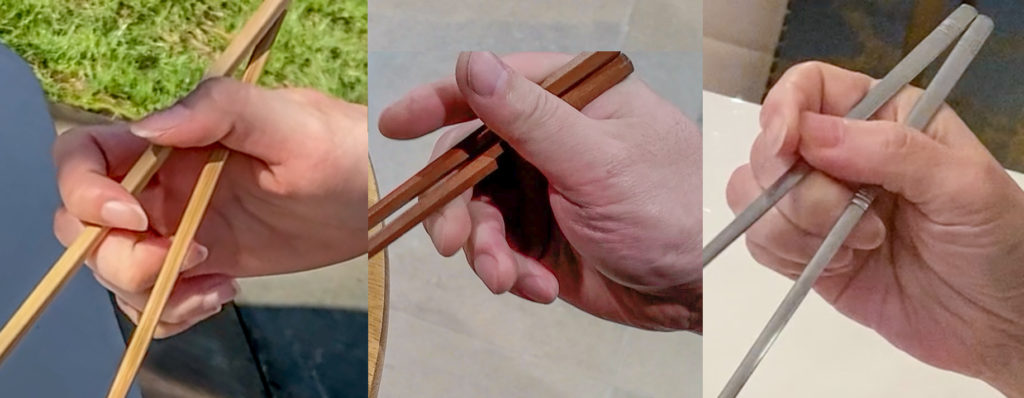
#HoldMarcosticksLikeAPen
#ChopstickCramp
* pictures courtesy of u/lesserweevils and u/sudakifiss.
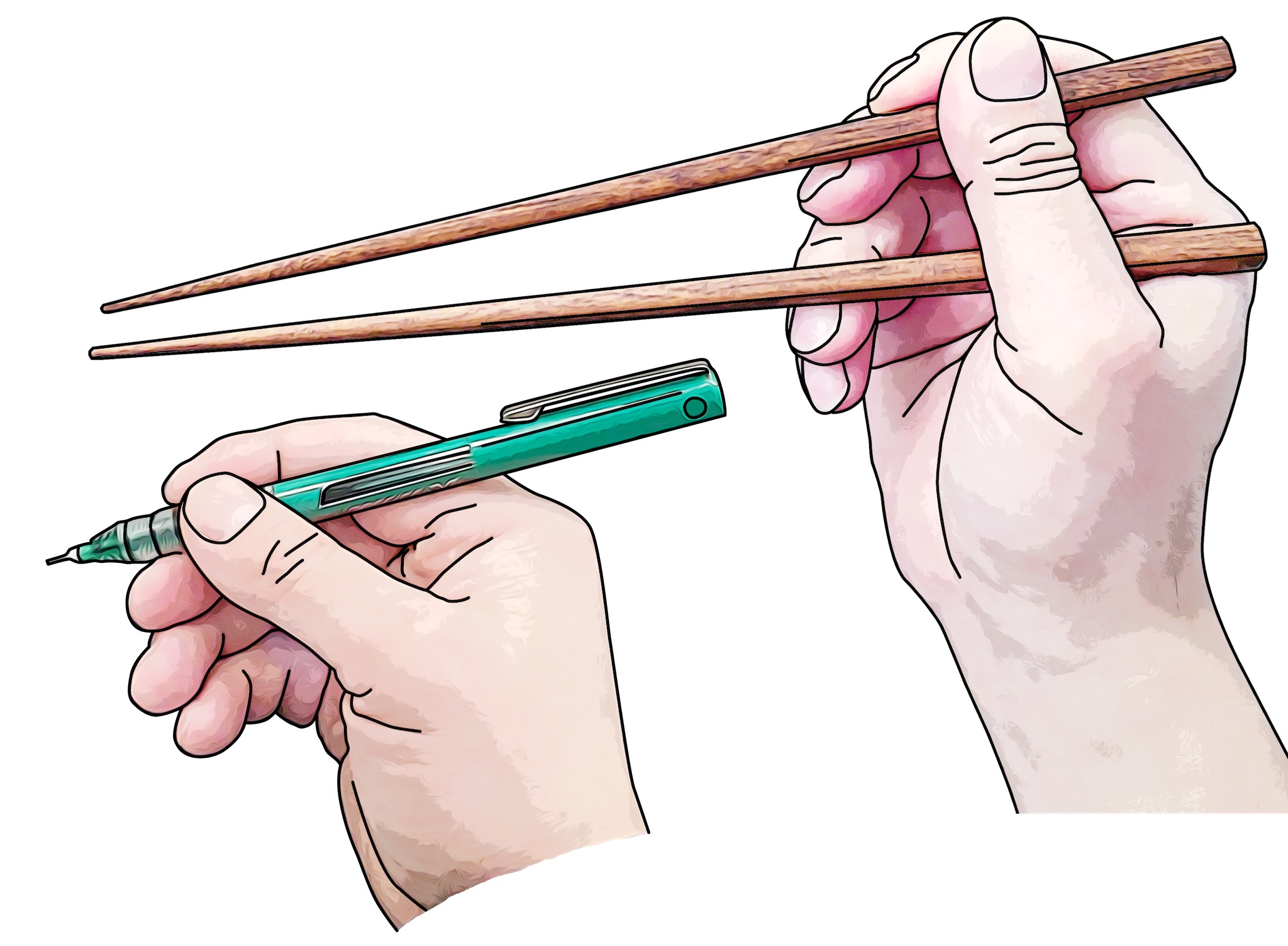

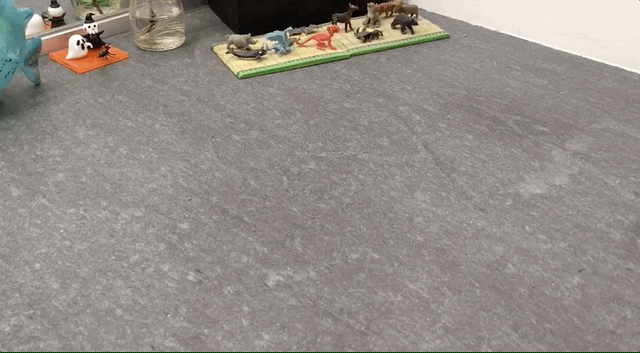
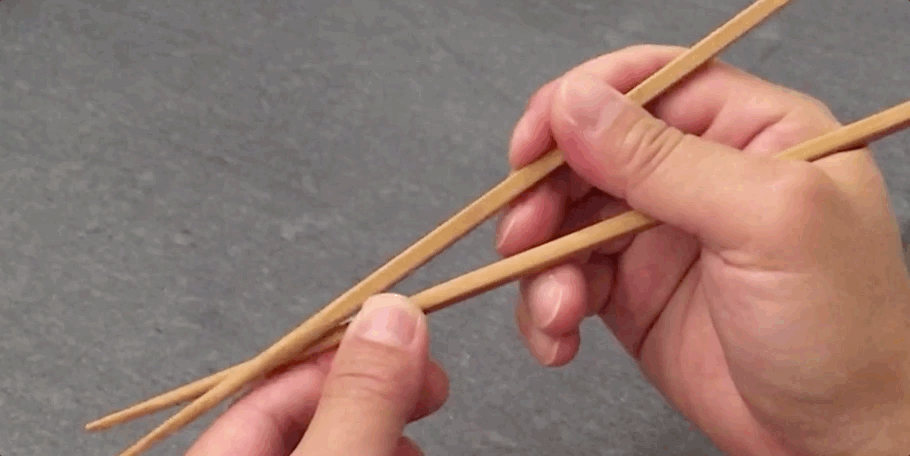
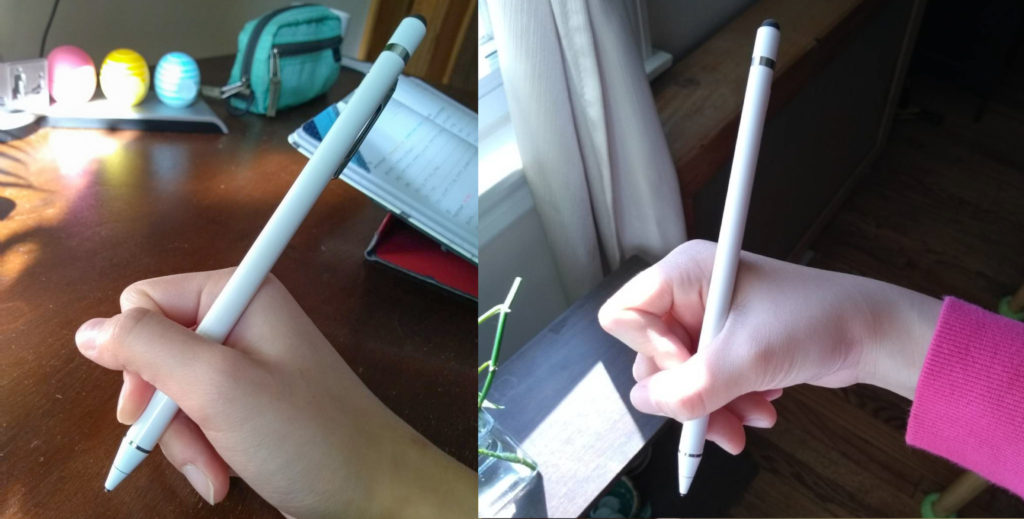
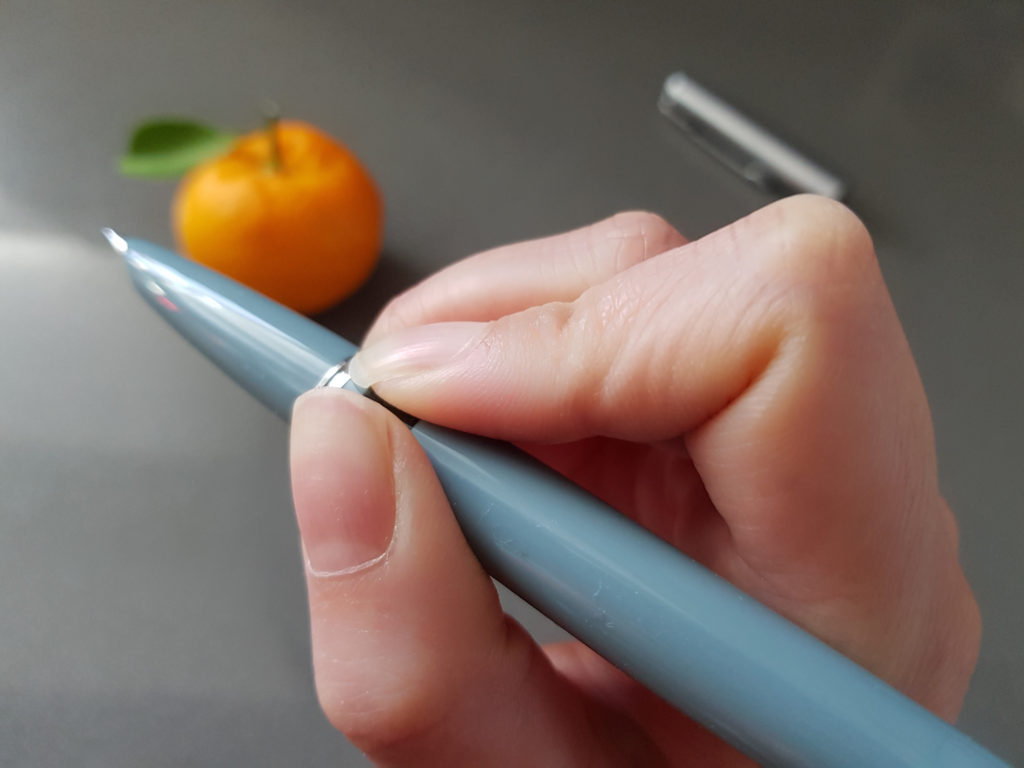
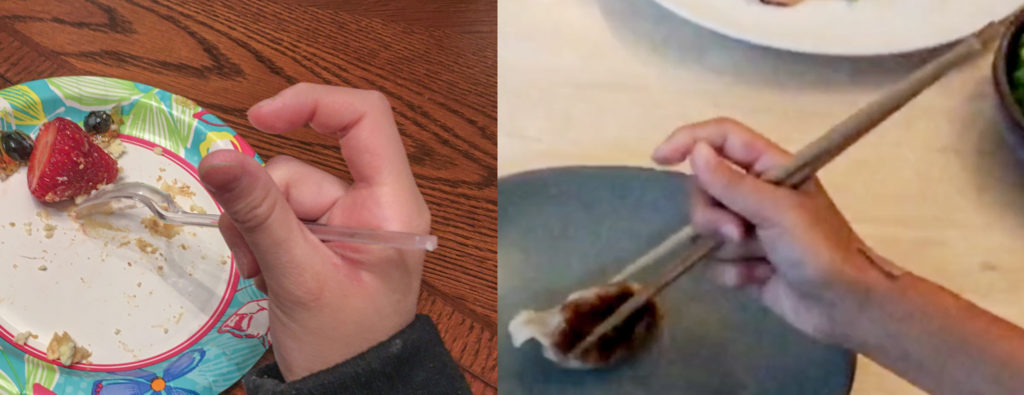
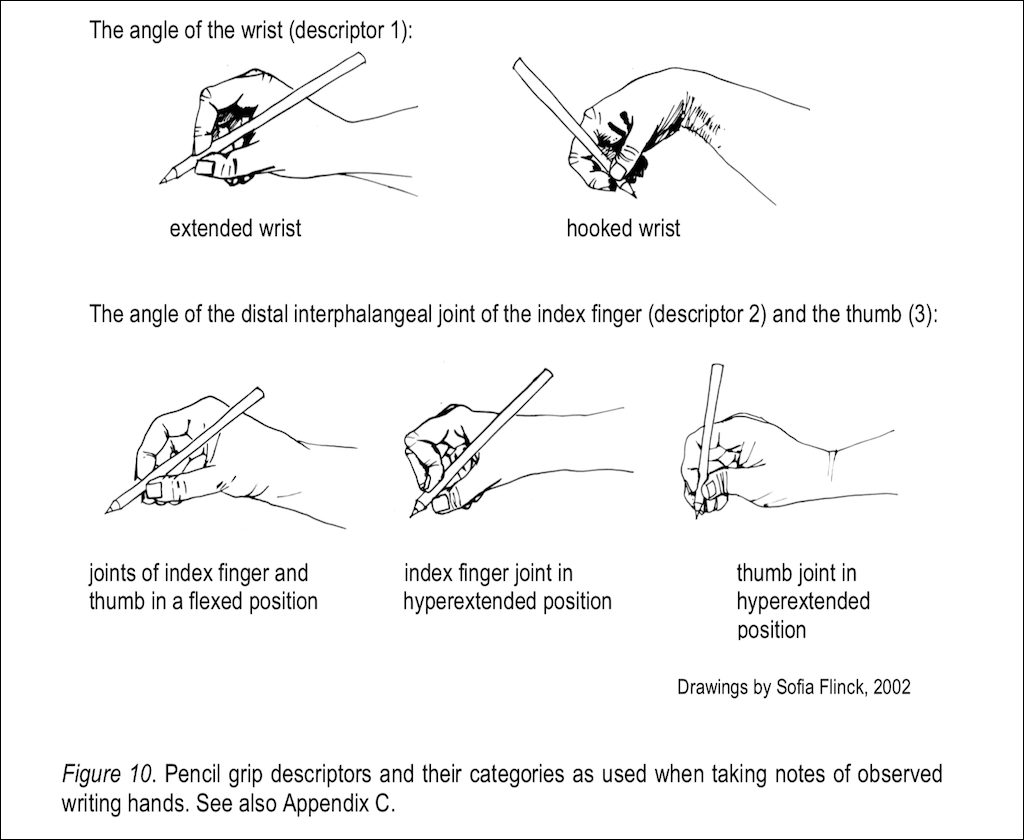
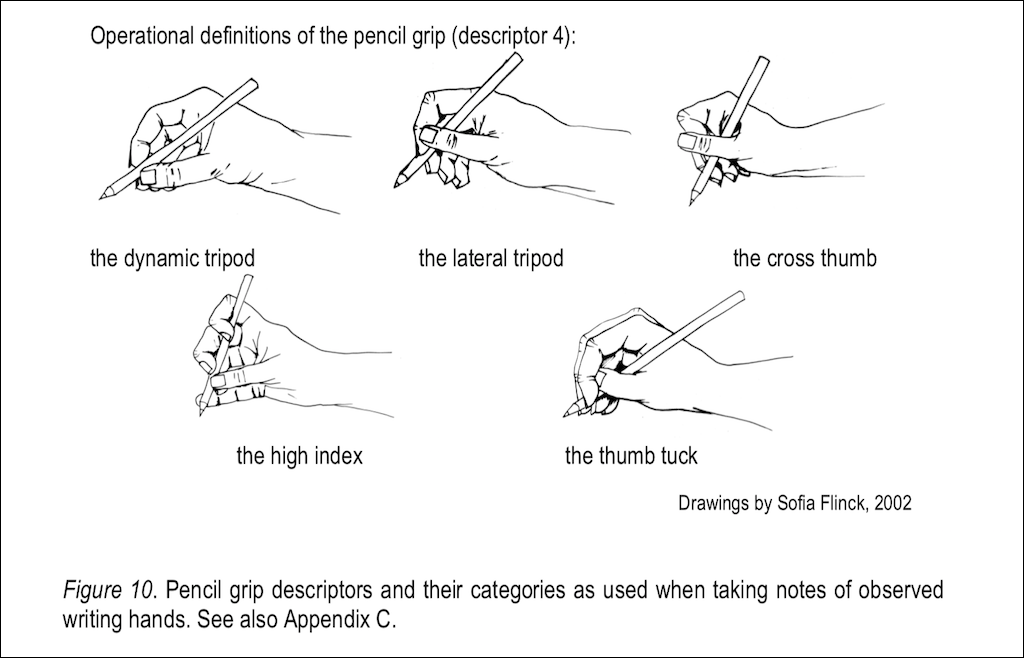
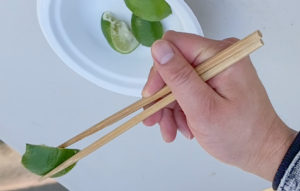
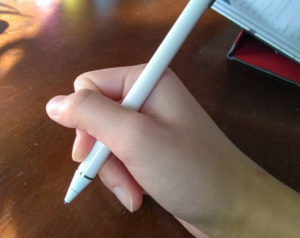
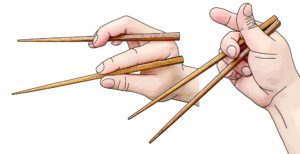
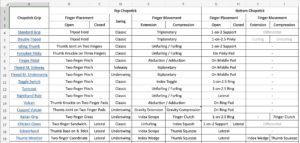

I’m surprised no one has commented yet but then it is a long article. However, I don’t have any of the aforementioned pen grips and when I try to correlate my unique grip to chopsticks, it doesn’t work. I’m half Japanese, born in Japan and my mother noticed I had difficulty holding the chopsticks the way she did. Realizing that my middle finger is longer than most, my index finger shorter, and my ring finger longer, and my thumb was longer when compared to the average hand with a shorter index finger when compared to the ring finger, she came up with an adaptation. I practiced until I could pick up a single grain of rice, I mean actually pick up, not just having it stick to the chopsticks along with picking up a grain of dry, uncooked rice. As an older adult, I have now developed STT joint arthritis, and even holding a pen much less a dinner fork can be painful and uncomfortable. So I now have difficulty using chopsticks as well and, especially since I’m Asian, it’s somewhat embarrassing. Interesting research. Thanks.
Welcome fellow nerd. You wonder why no one has commented on this article. It’s long, but definitely not the longest on this website. Ha ha ha. Your comment is also long, by comment standards. Thus the recognition that we have a fellow nerd visiting and commenting. Welcome again.
If you haven’t read our retrospective “The Art and Science of Chopsticking” at https://marcosticks.org/the-art-and-science-of-chopsticking/, you probably want to take a look. It will probably resonate with you, and may answer some of observations you commented here. The end of this pen hold article also mentions the same retrospective.
Briefly:
1. Everyone’s hand build is different. Not everyone can comfortably wield the so-called Standard Grip.
2. You may be interested in Dr. Rosemary Sassoon’s work on penhold.
3. You may want to consider sending us pictures and videos of your pen grip and chopstick grip. Perhaps your mom and you have come up with a grip we have not documented before. But of course, check out the grip guide first: https://marcosticks.org/catalog-common-chopstick-grips/. And, if you want to write an article for this website, or send us a draft for us to finish, you are very welcome to do so.
4. Your old grip doesn’t work for you anymore. Try some documented grips to see if some grips work for you, with your current condition? We know that some of these grips invite unwanted glances from native chopstick users. Ignore them. Most of them don’t even know they don’t use the so-called Standard Grip. They don’t know any better.